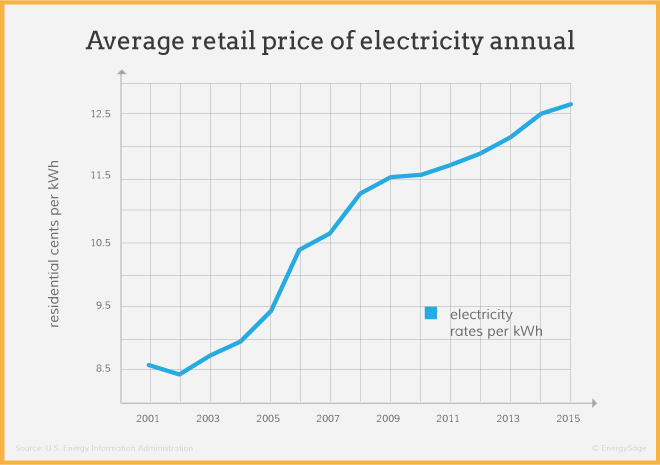
You may have seen recently that the California Public Utilities Commission (CPUC) has, once again, authorized California utility rate increases. While the actual percentage of increase varies depending on the region, customers across the state will see higher bills starting soon. Our solar experts took a look at the rate trends over the past few years to help homeowners better understand what this means and identify best steps moving forward.
California Electricity Rate Trends Over Time
Over the last 10 years, the residential electricity prices have skyrocketed. The average 2020 annual residential electricity bill was 25.9% higher than in 2010. Although this figure already seems high, when comparing it to national averages, you can see the gravity of these increases. In this same period, the average United States (excluding CA) electricity bill for all the other states grew only 1.6%. California homeowners on average saw a $257 increase in annual electricity spending during this time. Meanwhile, homeowners outside of California only saw a $22 increase.
Even as a leader in renewable energy, California’s residential prices remained the seventh highest in the nation. In 2020, California jumped up to the sixth highest rates in the US.
Homeowners should not expect to see the rate of increase in electricity prices slowing down any time soon. Southern California Edison (SCE) has filed a “General Rate Case” application with the CPUC proposing rate increases for residential customers starting in 2021. If approved, the average Edison residential customer’s electricity rates will increase from 18.1 cents/kWh to 20.7 cents/kWh which is a 14.4% increase. Other California investor-owned utilities (IOUs) have proposed similar increases.
Keep in mind, the average electricity rate in the United States is only 13.19 cents/kWh.
Why Are California Utility Rates Increasing?
There are a couple of factors that have influenced the California utility rate increases over time. One of the largest culprits? Climate change. The other biggest influence on the cost of electricity is the rate structure. More specifically, time of use (TOU) rates.
Climate Change & Utility Rate Increases
Climate change is submitting California to hotter, drier weather for longer periods, which increases the chance of arid winds fanning the flames. The blazes themselves contribute to the vicious cycle: forest fires account for 15 percent of California’s 2018 emissions of carbon dioxide, one of the main greenhouse gases that contributes to climate change. Over the last year and a half, Californians have experienced six of the 10 most destructive fires in the state’s history.
According to SCE, the purpose for their proposed increase is “to cover its anticipated costs from 2021 through 2024 for its employees to inspect, repair, and, when appropriate, upgrade poles, transformers and distribution lines. This includes reducing wildfire risk and upkeeping the safety of the grid.”
TOU Rates
The name for TOU rates varies depending on the utility company and region. Sacramento serves as a great example.
In 2019, Sacramento introduced peak rates. These new summer “peak” rates appear caused around a 40-200 percent increase on residents’ electric bills. The drastic increase in costs stems from the hours identified as “peak” hours. With the new policy, the utility charges residential users higher rates between 5:00 p.m. and 8:00 p.m. These are the hours when most people arrive home after work and begin their family rituals.
What Can You Do To Combat The Increased Rates?
As rolling blackouts become more frequent and energy prices skyrocket, energy independence initiatives are emerging. These act as a powerful tool to provide more reliable, cheaper energy for individual consumers like you.
In the wake of public outrage over extended blackouts in the 2019 wildfire season, cities like San Jose are considering investing in or expanding microgrids. These are connected to the larger IOU grid and can be turned on to provide power during outages or storms. Additionally, these structures allow municipalities to cut costs by using a less reliable or smaller local energy source to provide some of their own electricity, all while maintaining the IOU’s energy as a backstop against power shortages. A microgrid is an effective way to reduce reliance on IOUs. It does so without taking on the burden of operating a municipal power utility, a task that only cities like San Francisco can reasonably shoulder.

Going Solar
If you do not want to rely on these for-profit organizations to find more-affordable energy solutions, one of the most cost-efficient ways you can immediately reduce your electricity bill is by installing a residential solar system. For the most energy independence, homeowners can even opt in to purchase a backup battery system. Home batteries even complement the movement towards all-electric homes and electric vehicles.
If you want to combat California utility rate increases, then contact one of our solar energy experts. Our team expertly designs each home solar system, tailoring them to homeowners’ needs.
Not only will you stop overpaying for your electricity, by switching to solar, you will reduce your carbon footprint. Ready to make the switch to solar? Then contact us today!

Authored by Ryan Douglas
NRG Clean Power's resident writer and solar enthusiast, Ryan Douglas covers all things related to the clean energy industry.

